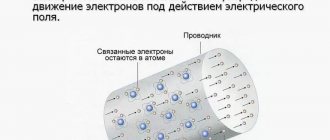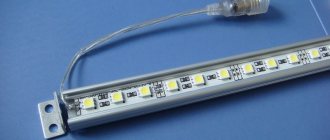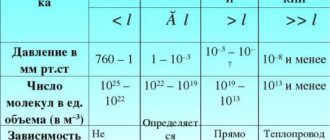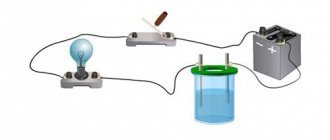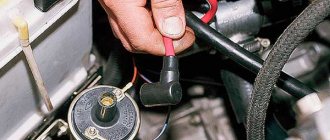Everyone is familiar with the definition of electric current. It is represented as the directed movement of charged particles. Such movement in different environments has fundamental differences. As a basic example of this phenomenon, one can imagine the flow and propagation of electric current in liquids. Such phenomena are characterized by various properties and are seriously different from the ordered movement of charged particles, which occurs under normal conditions not under the influence of various liquids.
Figure 1. Electric current in liquids. Author24 - online exchange of student work
Finished works on a similar topic
Course work Electric current in liquids 440 ₽ Abstract Electric current in liquids 230 ₽ Test work Electric current in liquids 220 ₽
Get completed work or advice from a specialist on your educational project Find out the cost
Conductivity of liquids
In order for a substance to conduct electric current, it must contain a certain concentration of charged particles that can move under the influence of an electric field. As in solids, such particles are not present in all liquids, therefore liquids, like solids, can be conductors and dielectrics. For example, chemically pure water contains practically no charge carriers and is a dielectric.
However, the conductivity of liquids containing free charged particles differs significantly from the conductivity of solids. If in solids atoms are arranged in a dense crystal lattice, and electrons can move quite freely between atoms, providing metallic conductivity, then in liquids there are no free electrons. Liquid molecules are located at sufficiently large distances that electrons cannot freely leave the nuclei.
Rice. 1. Liquid molecules.
Therefore, the conductivity of liquids is ensured solely due to the presence of charged ions in it.
Laws of physics and current in liquids
Electricity in our homes and equipment, as a rule, is not transmitted in metal wires. In a metal, electrons can move from atom to atom, and thus carry a negative charge.
As liquids, they are carried in the form of electrical voltage, known as voltage, in units of volts, named after the Italian scientist Alessandro Volta.
Also, electric current flows from high voltage to low voltage and is measured in units known as amperes, named after Andre-Marie Ampere. And according to the theory and formula, if you increase the voltage, then its strength will also increase proportionally. This relationship is known as Ohm's law. As an example, the virtual ampere characteristic is below.
Figure: current versus voltage
Ohm's Law (with additional details regarding the length and thickness of the wire) is typically one of the first things taught in physics classes, many students and teachers therefore treat electric current in gases and liquids as a fundamental law in physics.
In order to see the movement of charges with your own eyes, you need to prepare a flask with salt water, flat rectangular electrodes and power sources; you will also need an ammeter installation, with the help of which energy will be conducted from the power supply to the electrodes.
Pattern: Current and salt
The plates that act as conductors must be lowered into the liquid and the voltage turned on. After this, the chaotic movement of particles will begin, but just like after the emergence of a magnetic field between conductors, this process will be ordered.
As soon as the ions begin to exchange charges and combine, the anodes will become cathodes, and the cathodes will become anodes. But here you need to take into account electrical resistance. Of course, the theoretical curve plays an important role, but the main influence is the temperature and the level of dissociation (depending on which carriers are chosen), and whether alternating or direct current is chosen. Completing this experimental study, you can notice that a thin layer of salt has formed on solid bodies (metal plates).
Ions and ionic bonding
An ion is a part of a molecule in which the number of electrons is not equal to the number of protons in the nuclei of its atoms, and thus the ion always has some charge.
Ions are formed due to the fact that there are energetically stable configurations of electron shells in atoms, the number of electrons in which has certain values - most often, 0, 2 or 8 electrons.
For an atom whose number of outer electrons is close to these numbers, it is “energetically favorable” to change the number of electrons so that the number of electrons in the outer shell becomes stable, even despite the acquisition of an electric charge.
Sodium has one electron in its outer electron shell, so sodium loses it very easily, becoming a positive ion. Chlorine has seven electrons in its outer electron shell, so chlorine easily incorporates one free electron into the shell, becoming a negative ion. These two processes can be combined - sodium transfers an electron to chlorine, resulting in two oppositely charged ions that are immediately attracted to each other. Therefore, sodium burns in chlorine, producing white smoke consisting of tiny crystals of ordinary table salt $NaCl$.
Rice. 2. Combustion of sodium in chlorine.
A chemical bond that occurs due to the formation of ions is called ionic. This connection exists in almost all acids, salts and alkalis.
Faraday's law of electrolysis
The mass of the substance released on the electrode during the time Dt during the passage of an electric current is proportional to the current strength and time:
k – electrochemical equivalent of the substance (
).
The resistance of the electrolyte decreases with increasing temperature because the number of ions increases due to electrolytic dissociation.
Faraday's law allows us to determine the charge of an electron:
The conclusion about the existence of an elementary electric charge in nature was made by Helmholtz in 1881.
Electrolytic dissociation
If a substance whose molecules are formed by an ionic bond is melted, then first the molecules move further and further away from each other due to temperature, and then a certain moment comes when the ions forming the molecules also move so far away from each other that it becomes possible for them to form ionic connections with other ions. Thus, in the melt of a substance, due to temperature, mobile charged particles appear that are capable of moving under the influence of an external electric field.
The effect of temperature can be replaced by the effect of solvent. If the solvent molecules are a dipole (for example, ordinary water), then these molecules can interact with the ions of the crystal lattice of the solute, carrying them into the solution. Charged particles appear in the solution and can move under the influence of an electric field. This usually happens at lower temperatures. For example, if molten table salt requires a temperature of more than 800⁰C, then the dissolution of the salt occurs at room temperature.
The breakdown of a substance into ions to form a conducting electrolyte under the influence of temperature or solvent is called electrolytic dissociation.
Rice. 3. Ionic electrolytic dissociation.
Thus, a liquid can conduct electric current if it either itself consists of ions or is a solution of a substance with an ionic bond.
What have we learned?
Electric current can exist in liquids if the liquid contains free charged particles - ions. Such particles can exist either if the molecules of the liquid consist of ions, or if a substance with an ionic bond is dissolved in the liquid (for example, a melt or a solution of table salt). A liquid that does not contain ions (for example, chemically pure water) does not conduct electric current.
Previous
PhysicsGas laws - formulas for ideal gas
Next
PhysicsEquipotential surfaces - lines of force, properties and examples of the electric field
Electric current in semiconductors
Semiconductors include elements of the fourth group of the table of chemical elements by D.I. Mendeleev, which have 4 valence electrons. The intrinsic conductivity of semiconductors is electron-hole .
At low temperatures, all electrons participate in the creation of covalent bonds, there are no free electrons, and the semiconductor behaves like a dielectric. When the temperature increases or irradiation of semiconductors, some of the covalent bonds are destroyed, and free electrons appear. At the site of the broken bond, an electron vacancy appears - a hole . It also moves around the crystal and behaves like a positive particle.
The dependence of the resistivity of semiconductors on temperature and external radiation is shown in the graph.
Impurity conduction can also occur in semiconductors .
Donor impurities are elements of the fifth group of the table of chemical elements of D.I. Mendeleev. Only 4 out of 5 valence electrons are involved in creating covalent bonds. The rest immediately become free. A semiconductor in which negative electrons are the main carriers is an n-type semiconductor.
Acceptor impurities are elements of the third group of the table of chemical elements by D.I. Mendeleev. Three valence electrons form covalent bonds, and a hole appears in the fourth place. A semiconductor with positive carriers is a p-type semiconductor.
Applications of semiconductor devices
Thermistors are devices whose resistance changes when heated. They make it possible to detect small changes in temperature.
Photoresistors are devices similar to thermistors, but the resistance in them changes not with changes in temperature, but with changes in illumination.
A semiconductor diode is a connection of two types of semiconductors. Has one-way conductivity.
Applications of Electrolysis
Refining (cleaning) of metals
The process takes place in an electrolytic bath. The anode is the metal to be purified, the cathode is a thin plate of pure metal, and the electrolyte is a solution of a salt of a given metal, for example, when refining copper, a solution of copper sulfate.
Under certain conditions, pure copper is released at the cathode, and impurities precipitate or go into solution.
Electrometallurgy
Some metals, such as aluminum, are produced by electrolysis from molten ore. An iron box with a coal hearth serves as an electrolytic bath and at the same time a cathode, and carbon rods serve as an anode. The temperature of the ore (about 900 0 C) is maintained by the current flowing through it. The molten aluminum drops to the bottom of the box, where it is released through an opening into a mold for casting.
Galvanostegy
An electrolytic method of coating metal products with a layer of noble metals that cannot be oxidized.
Electrotype
Used to reproduce the shape of relief objects (medals, coins, exact copies of artistic products).




